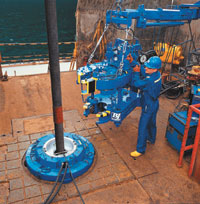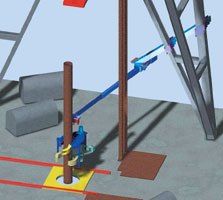Automated power tongs provide safer, more efficient operation
OIL COUNTRY TUBULAR GOODSAutomated power tongs provide safer, more efficient operationControl, stability and flexibility characterize one-man power tong manipulation system used on the North Sea’s Brent Delta platformNeil Gordon, BJ Tubular Services, Aberdeen, Scotland
Described here is an automated hydraulic power tong system developed by BJ Tubular Services that has proven to provide safe, efficient service in many environments, including a recent North Sea application. Traditional Approach / Alternative Conventional oilfield casing and tubing operators use hydraulic power tongs suspended from a line attached to the crown block area of a drilling derrick. These tongs, weighing upwards of 2,000 kg (4,400 lb), are difficult to move back and forth from the well centerline. The process is further complicated by need to ensure that the tugger line that suspends the tong does not foul the top drive system. These conditions make moving the power tongs labor intensive, requiring up to three crew members. Given the weight of the equipment and repetitive nature of the work, risk of injury, particularly to the hands, is increased. A relatively new method of handling hydraulic power tongs during casing and tubing operations employs an automated tong manipulation system. To improve safety and reduce risk of injury, BJ Tubular Services created the Leadhand MK II hydraulic power tong system to assist in maneuvering hydraulic power tongs to and from the well centerline. Operating Principle The system is a hydraulic, telescoping tube – or articulating arm – that features several mounting points to provide flexibility. It incorporates a hydraulic power supply and remote control panel. The arm is mounted in the derrick using brackets that allow the system to be rigged up or down in l0 to l5 min. This system requires only one operator to move the tong back and forth from the well center, Fig. 1.
Hydraulic power is supplied to the actuating cylinders via a series of valves that control extension and retraction speeds, as well as force generated by the cylinders. Hydraulic power may be drawn from a self-contained, temporary power unit, which is normally provided to drive the casing tong, or from the rig’s existing hydraulic supply. One operator remotely pilots the hydraulic control valves via a small joystick mounted on the tong. The joystick allows the operator to move or extend the tool at varying speeds, depending on the circumstance. This flexibility ensures that the operator can accurately position the tong for makeup / breakout operations. Further flexibility arises from integral backup tongs that can be used for tubular sizes up to 20 in., thus eliminating the need for load-bearing snub lines. The interface between power tong and the tugger line that supports it allows the tong to hang level, even when the tugger line is inclined from the vertical. The unit uses a static hanging line and transmits only low levels of loading into the rig structure, making installation a simple, straightforward procedure. By using the existing tugger line, overall lifting capacity is also greatly enhanced. When fully retracted, the unit measures 2 m (6.5 ft) and offers a dynamic stroke of 4 m (13 ft). Attachment adapters allow the system to be fixed to mounting points between 4 and 7 m (13 and 23 ft) from the rotary centerline. The system accommodates various manipulation scenarios, even where the tong must be operated in a position outside of its range. For example, if the unit must be operated over the mousehole for special assemblies, the attachment bracket may be easily disconnected by removing two pins, thus allowing the tugger line and lifting bridle to remain attached to the tong for safer, quicker operation. Given the environments within which the system operates, the automated approach is more reliable, because it does not depend on electrical switches. This also satisfies Hazardous Area certification requirements. North Sea Application Since 1997, the system has been used in many casing and tubing operations, and in May 2001, the system was installed to remove a 7-in. completion on Brent Delta, one of Shell UK Exploration and Production’s (Shell Expro) Brent field platforms located in Block 211/D29. Under normal operating conditions, the load transmitted from the unit to the supporting structure is very low (about 150 kgf). This force is limited by regulating hydraulic pressure fed to the cylinders on the unit. The mounting system is designed under the assumption that all control valves have failed, and that a higher level of pressure is being supplied. In this failure mode, significantly higher forces might be transmitted to the mounting structure. The optimum location for installing the automatic power tong manipulation was an area of the rig floor where, unfortunately, there was no suitable substructure upon which to attach the articulated arm. To overcome this limitation, BJ used a cantilevered beam measuring 4 m (13 feet) and mounting brackets to attach the arm to one of the derrick legs, Fig. 2. Traditional and finite element analysis conducted on the design showed loading on the beam and mounting brackets was well within acceptable limits.
An equally critical issue on Brent Delta was the additional available load-carrying capacity of the derrick legs, relative to actual distribution of loads imparted by the power-tong system in the "failure" mode. A design model of the proposed Brent Delta unit installation was generated to analyze available capacity of derrick elements that would support the system. This computer model revealed that the derrick elements could not handle the loads imparted by the system in the "failure" mode. The problem was solved by fitting shear pins to the system’s hydraulic cylinder attachment points to limit force transmitted by the system if the hydraulic system fails. This modification proved to be a significant safety improvement and all the units were similarly modified. Drilling contractor KCA Drilling and operator Shell Expro have cited the safety benefits of the system. Both noted its ability to provide good control, with a high level of stability and minimal tong handling. Shell realized many other benefits from this operation:
In sum, use of the Leadhand MK II for the Shell Expro
Brent Delta operation created a much safer working environment during the casing and tubing operations. All
the systems are being modified with shear pins to further improve safe operation, with additional attachments
being considered, such as a mud bucket to reduce associated manual handling risks.
|
|||||||||||||





